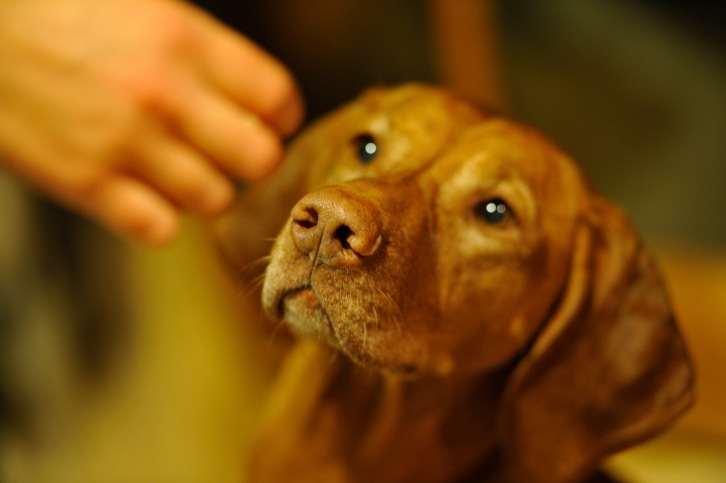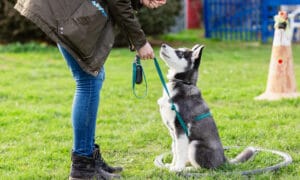“This post contains affiliate links, and I will be compensated if you make a purchase after clicking on my links.”

More and more trainers are switching to a positive style of training these days. This makes me rather happy as I have made the switch myself. I figured I would answer some questions and address some misconceptions involved with positive training because I feel like there are still a lot of people that don’t fully understand how it works and the benefits that can come from it.
What is Positive training exactly?
When the term “positive” is used in regards to training it means to add something. If you are trying to increase the frequency of a behavior you can add something that the dog enjoys directly after the dog does the behavior. This is referred to as Positive Reinforcement. By doing this, it makes the dog very likely to repeat the behavior that got him the good things. Positive training focuses on teaching the dog what to do, and then positively reinforcing it, which makes it very likely the dog will do it again.
An example would be rewarding the dog for sitting instead of jumping when a guest arrives. If the dog greets the guest by sitting it receives the attention it is looking for or even another type of reward that is of higher value. By rewarding the dog for sitting, it is very likely that the decision to sit when guests arrive will happen again. Just like any style of training, in order to have success with this system you need to have repetition. This repetition represents practice runs. Just like humans, dogs have to practice their skills to sustain or increase their abilities. The idea behind this is it teaches the dog what you would like it to do. It also teaches the dog what it needs to do in order to get what it wants.
Do Positive trainers use punishment?
The answer is yes. Positive trainers do use punishment. By definition punishment is doing something that decreases the frequency of a behavior. There are two ways to decrease the frequency of a behavior. You can add something, (Positive Punishment) or you can take something away, (Negative Punishment.) Positive trainers ironically do not use Positive Punishment. What positive trainers use when it comes to punishment is the Negative variety. Here is an example of how to use Negative Punishment: Guest arrives and the dog is overly excited resulting in lots of jumping. To punish this behavior the dog is removed for a minute or two. After the time is up the dog is allowed to try to greet the guest again. If the dog makes the correct decision it is allowed to greet the guest. This works by taking away what the dog wants. What I like about this is that if the dog is willing to put up such a big stink about the guest, it means the dog really wants to meet the guest. This means that taking the guest away will be an effective way to teach the dog what is appropriate and what is not.
But I’ve tried Positive training and it doesn’t work.
I see this statement online more than anywhere and it is a big reason why I decided to write this. I feel like not fully understanding how positive training works is a big reason why some people don’t see the results they are looking for. Also, just like any style of training, repetition is a must to have any success. What I have found with doing this style of training is that it takes fewer repetitions to get to the desired point than other styles. I think patience is a big part of this too. Owning a dog takes patience. If you are not a patient person, owning a dog may not be the right choice for you.
Also, there are thousands of trainers around the world that are successfully helping dogs (and their people) conquer their issues using only positive methods. These issues can be small like basic obedience all the way up to big problems like severe behavioral issues. My question is; how could thousands of people be employed doing something that doesn’t work?
But the dog is only doing it because I have food.
There is a difference between positive reinforcement and bribery. If I hold a hotdog out in plain sight and tell a dog to come, I would be bribing it. There is nothing wrong with using food as a tool to train. It can be an excellent motivator. The ultimate goal is to build habits, so why not use something that the dog really enjoys? Wouldn’t it make the dog develop habits quicker if it were getting things it likes along the way? The answer is yes. Working together as a team allows you to accomplish things much quicker. It works out well because the human gets what it wants, (Dog to do a certain behavior) and the dog gets what he wants. (Toy or food reward.)
But it won’t work for serious issues.
This is false as well. As I mentioned above, there are thousands of trainers that do this for a living that only use positive methods. The science behind fixing serious behavioral issues consists of addressing the underlying issue of why it is actually happening. By changing the way that the dog feels about _______, the unwanted behaviors associated with it start to dissipate as well. The only reason why this won’t work for serious issues is because you don’t fully know what you’re doing. This isn’t a jab at you; this is why professionals do it for a living. Hiring a professional is a great way for you to learn how to train and accomplish things in a positive way.
But a strong dog needs a strong hand.
As a professional trainer I work with any breed of dog. I’ve worked with Rotts, Mastiffs, Pits and a lot of the other “strong” breeds out there. My methods don’t change with them because I get results the same way I do with any other dog.
But I’ve always done it another way.
There is not a better time to switch than now. I switched, so can you! By switching you can see how much fun training your dog can be! It is such a wonderful feeling to see your dog’s skills increase. (And yours.) Don’t be afraid to switch. Once you get the hang of it you will have a lot of fun!
Check out some of my YouTube videos below to help you get started! Click the Subscribe button for automatic updates when new videos come out.
Click here: http://www.youtube.com/channel/UCFE9vxI1W0bxh0aPu8Ms7Ww
Kevin is a Certified Professional Dog Trainer through the Certification Council for Professional Dog Trainers (CCPDT.org) and is a Canine Good Citizen Evaluator through the American Kennel Club. He currently resides in Ohio with his dog, V, a six-year-old Shepherd/Lab mix, where he operates All Dogs Go To Kevin, LLC, specializing in helping build positive relationships between humans and their canine companions using clear communication, not pain and fear. For more training tips and tricks, and to meet his amazing dog, V, follow him on Facebook by clicking here.























